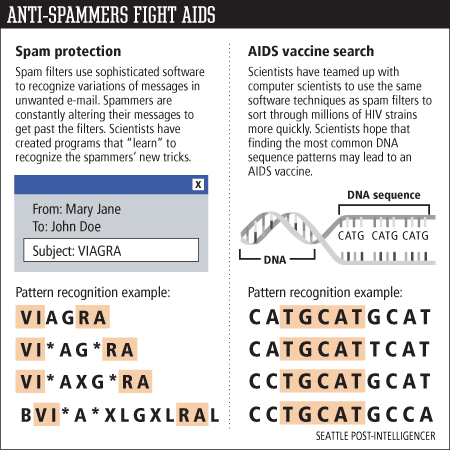Scientists hope method will find patterns in variations of HIV
By Tom Paulson, Seattle Post-Intelligencer, February 23, 2005
Software scientists at Microsoft Research have teamed up with biomedical researchers in Seattle, Boston and Perth, Australia, to see if computer techniques used to defeat e-mail spam can also be used to help design a vaccine that can defeat AIDS.
Today, members of this unique collaboration will announce a plan to use "machine learning" or "data mining" computational techniques to decipher HIV's wildly creative genetic ability to constantly change and disguise itself from immune system detection and deletion.
"HIV mutates like crazy, but it does show a pattern," said Dr. David Heckerman, a physician and computer scientist at Microsoft Research.
"It isn't completely random," added Heckerman's colleague Nebojsa Jojic. Just as a spammer can add only so much nonsense or other disguising characters without obscuring the message, Jojic said, so can the AIDS virus vary only so much without disabling itself.

The two plan to announce the innovative approach to seeking an AIDS vaccine today in Boston at the 12th annual Conference on Retroviruses and Opportunistic Infections, perhaps the most prestigious AIDS research meeting in the world.
"The genetic variability of this virus is a major problem in finding a vaccine," said Dr. James Mullins, a University of Washington microbiologist and AIDS researcher working with the Microsoft scientists.
There are millions of different variations of HIV, Mullins said, and the standard approach to vaccine development typically requires extensive testing of experimental vaccines against specific strains or select groupings of similar strains.
"It's just not that manageable," he said.
The basic idea behind "machine learning" -- a form of artificial intelligence -- is to make this search more manageable by letting a computer sort through and analyze all the information and variations to look for revealing, repeat genetic patterns in HIV.
Just as a computer's spam filter "learns" to recognize new variations from the same spammer, it is hoped a computer can learn to decipher some fundamental repeat patterns about HIV's genetic variability and narrow the search for vaccine targets.
"HIV mutates by making errors in its (genetic) copying," Jojic said. But it can make only so many errors, he said, if it hopes to retain the genetic equivalent of the spammer's intended e-mail.
If these techniques can identify genetic sequences retained by HIV despite its many disguises, the researchers believe this could identify critical parts of the viral DNA to target in developing a vaccine.
Heckerman, who was trained as a physicist before veering off into medicine to study the brain before being diverted again into the artificial intelligence field, sees this partnership as a logical extension of his interests. He pioneered e-mail spam filtering in the late 1990s and contends Microsoft is holding its own against spam.
Unlike spammers, he noted, the AIDS virus likely won't try to further alter itself in some more perverse way in response to being scrutinized.
Mullins said he learned of Heckerman and Jojic's work from a post-doctoral student a few years ago and sought them out.
He said he had earlier used another kind of computational analysis studying HIV's earliest genetics to identify common patterns that might be good vaccine targets. He made and tested in rabbits an experimental vaccine developed by that method, but said, "The results were not that great."
This new effort is unique and orders of magnitude more powerful, the team said. Using a series of computerized problem-solving techniques they call "epitomes," they plan to comb through millions of genetic sequences looking for patterns that "epitomize" the fundamental nature of HIV.
Microsoft Research has been using this technique to reduce or compress video and audio information down to its essential information.
For an AIDS vaccine, the team hopes to find the smallest essential quantity of genetic information needed to fight off different strains of the deadly virus. They said they have already started testing experimental vaccines in the laboratory, exposing them to blood samples taken from HIV-infected people.
If the approach is successful, the scientists said they may expand into other areas such as the development of treatment for hepatitis C infection and other highly mutating viruses.
AIDS kills more then 8,000 people every day and has claimed more than 30 million lives since it was first identified. Nearly 40 million people are infected worldwide, and nearly 5 million more are infected each year.

